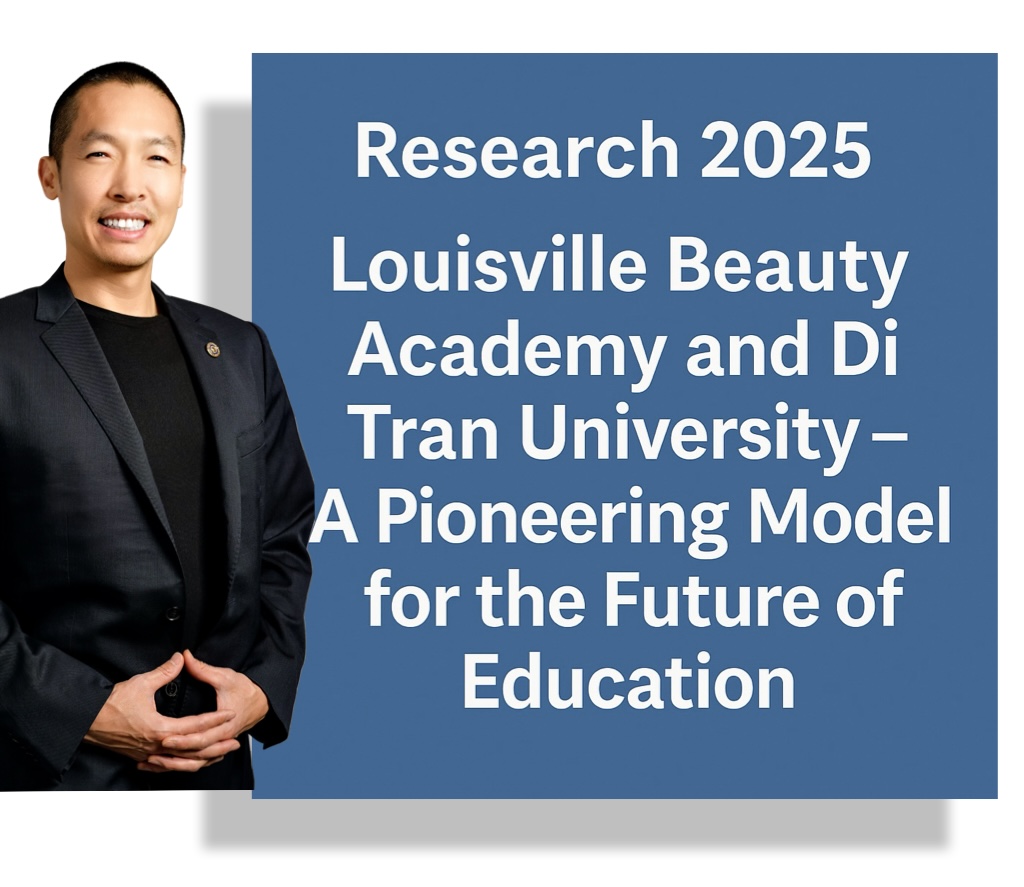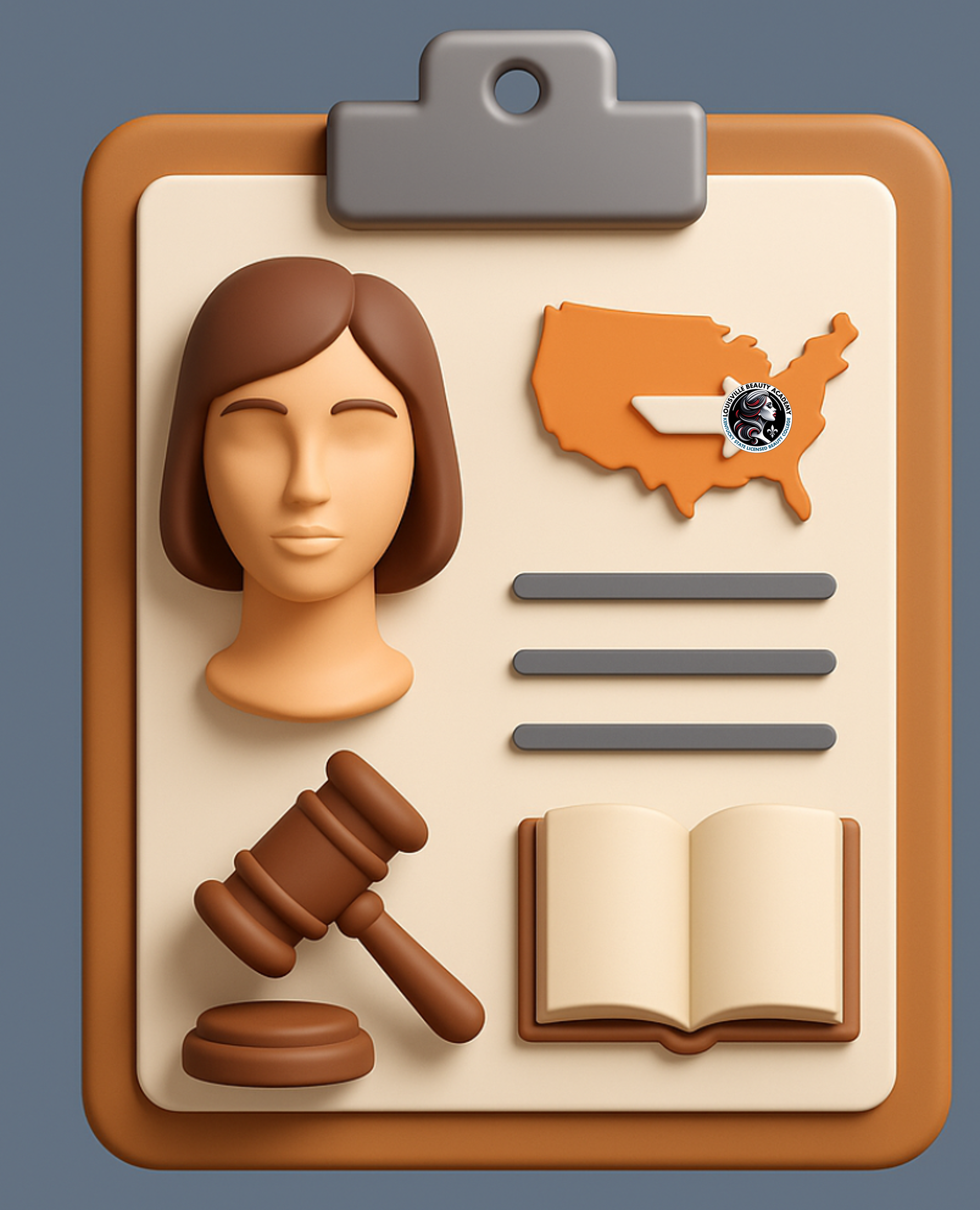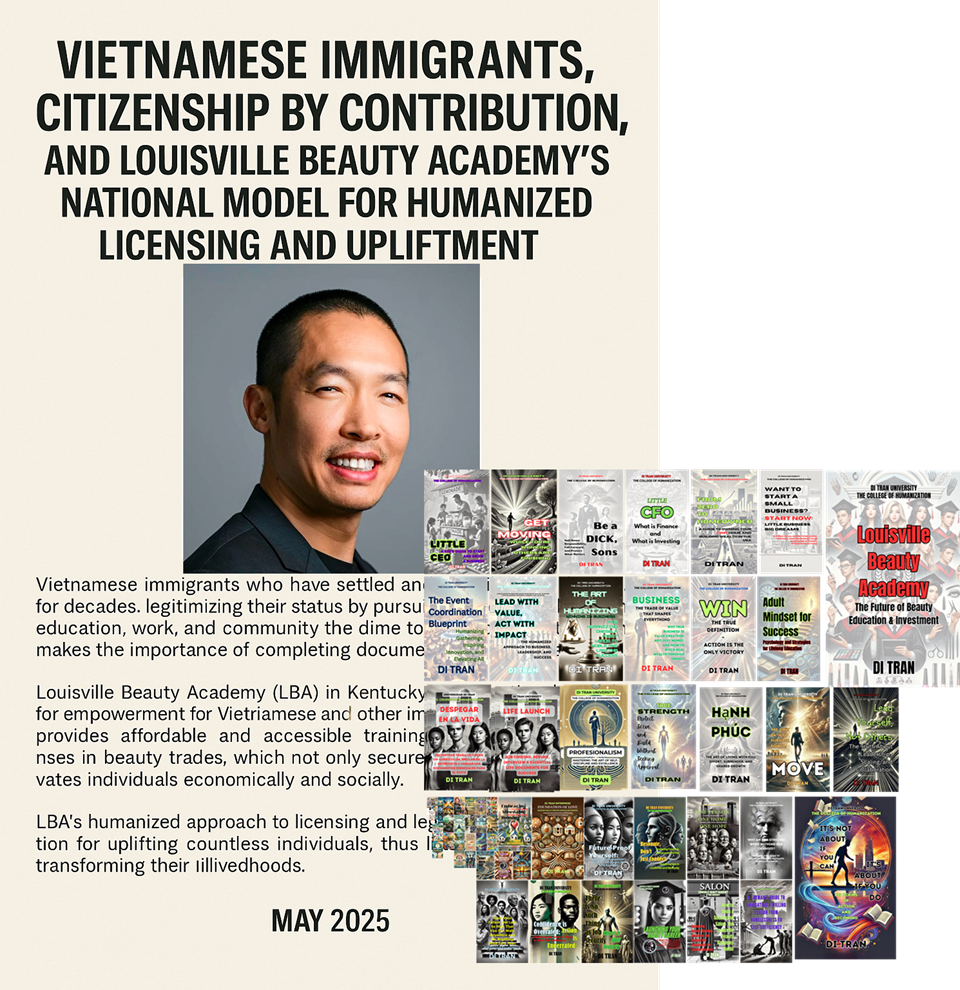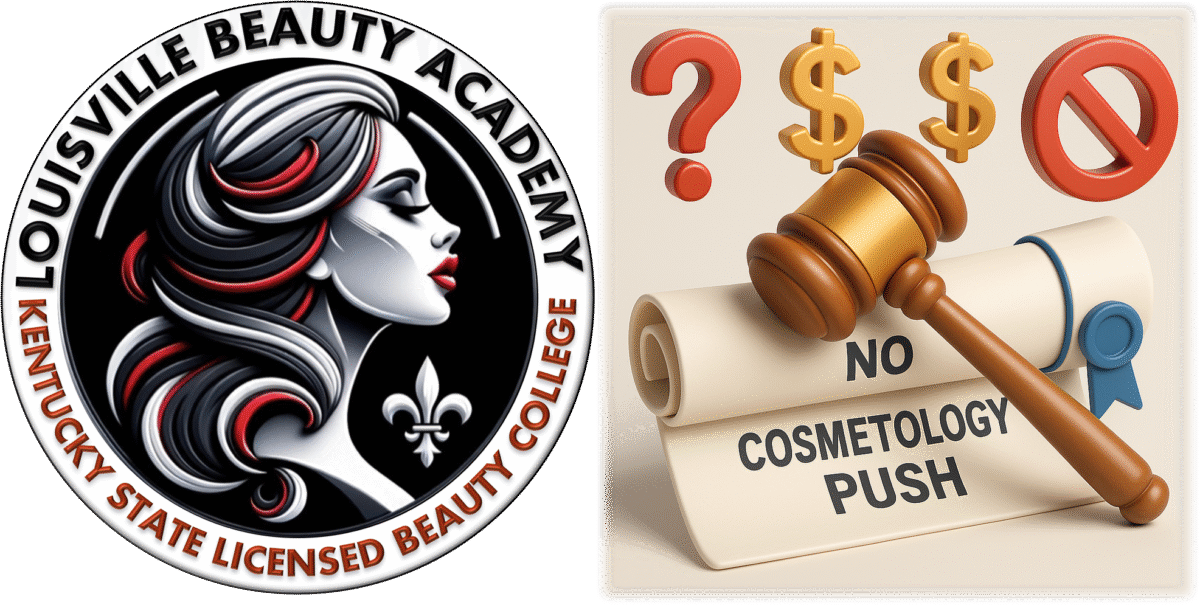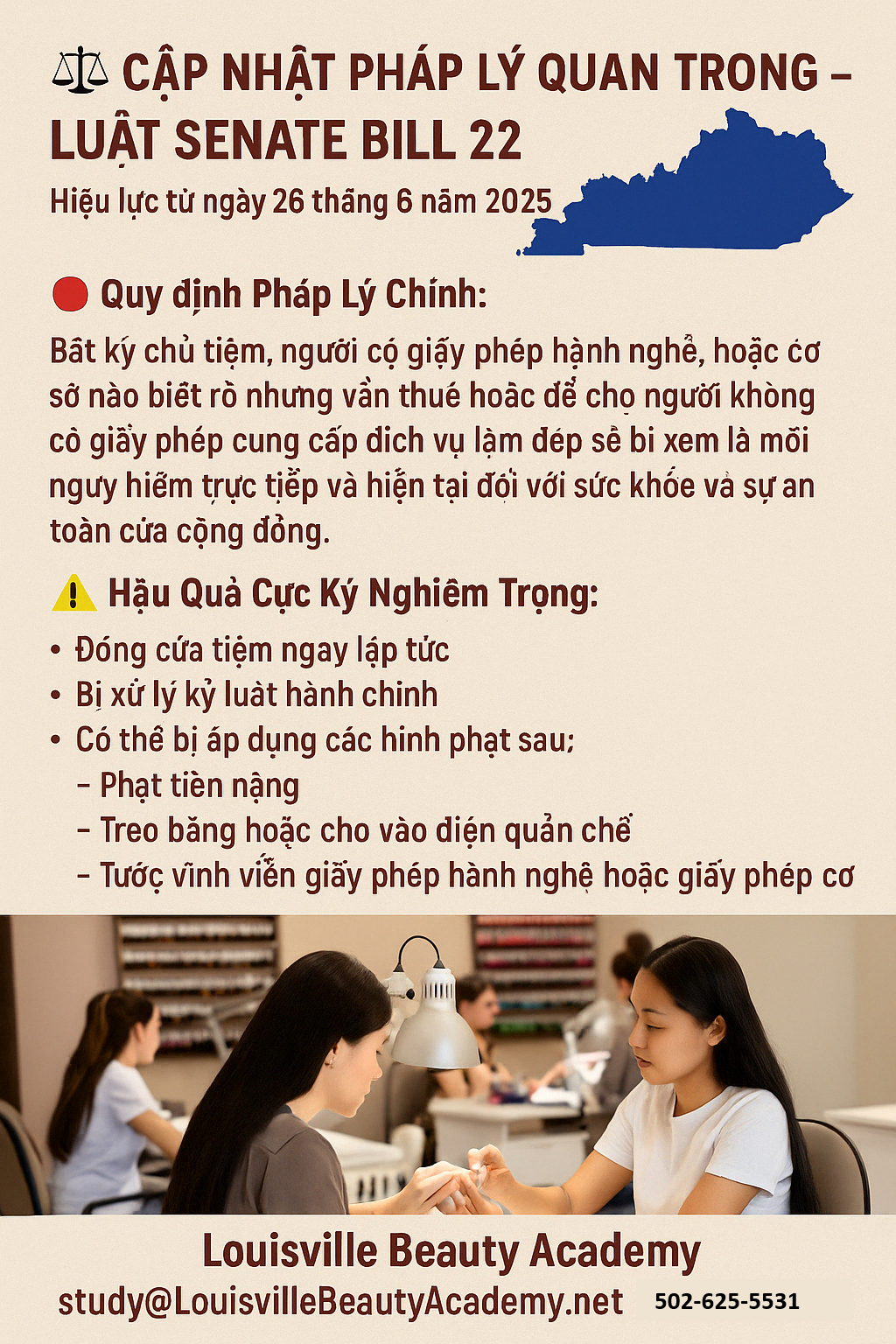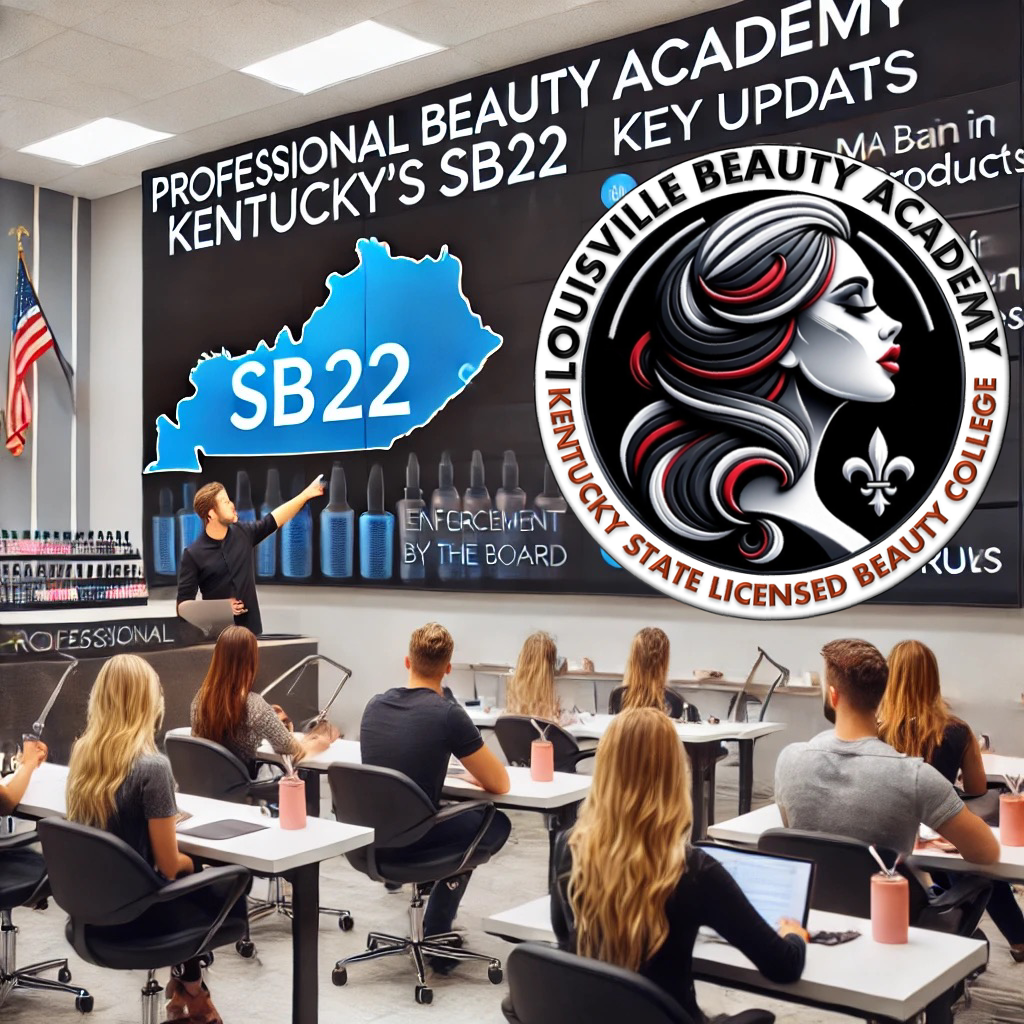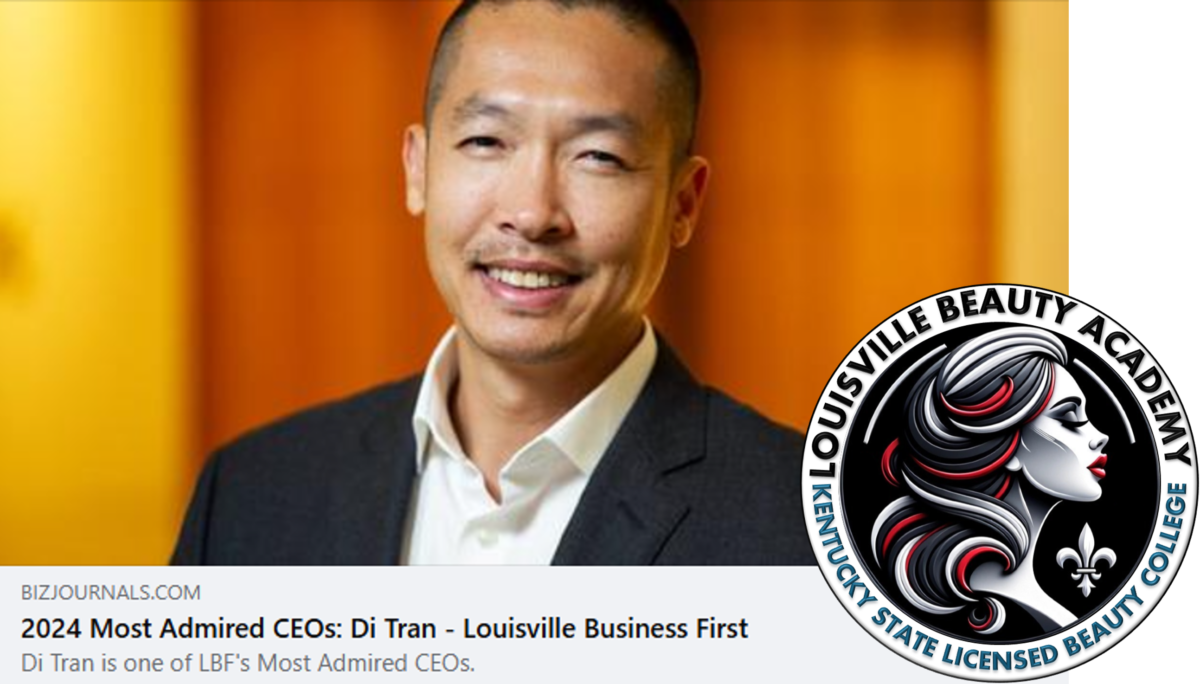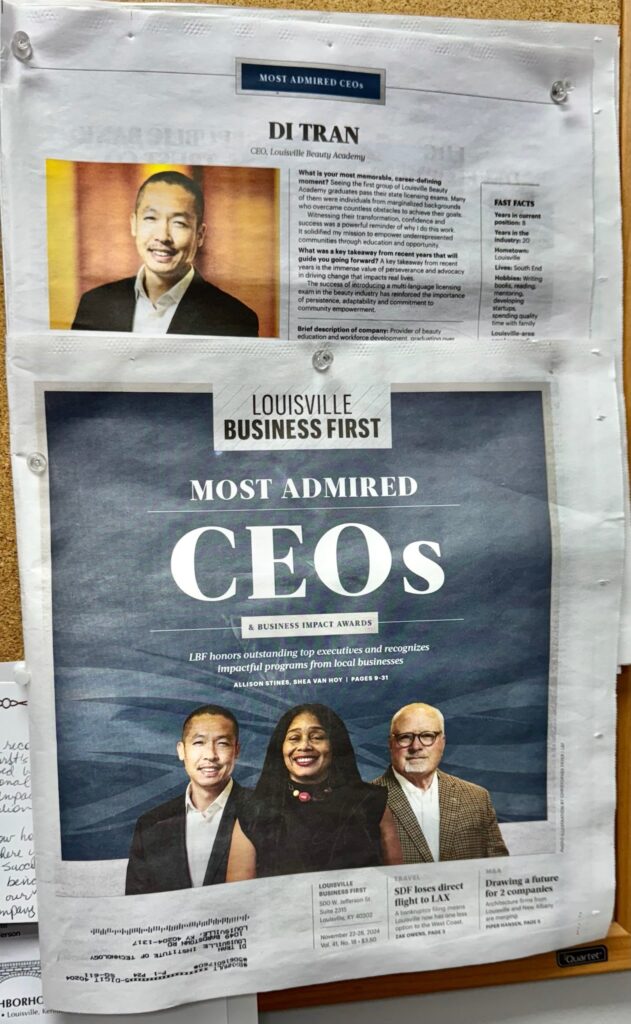
AI-Powered, Human-Centered Learning Environment
Louisville Beauty Academy (LBA) and the emerging Di Tran University exemplify cutting-edge AI adoption in education. At LBA, students have access to generative AI tools like ChatGPT and D-ID’s AI video avatars as part of their daily learning. These tools provide on-demand translation, multilingual tutoring, and instant Q&A support in 100+ languages, ensuring even non-English-speaking students can fully participate. For example, a prospective student can interact with an AI video guide (speaking Spanish, Vietnamese, etc.) to learn about enrollment and licensing steps. This 24/7 personalized support via chatbots and avatars augments human instructors, creating a multilingual, inclusive, and human-centered classroom where no one is left behind. LBA’s model intentionally blends in-person mentorship with these AI-assisted tools – a “technology-assisted, AI-supported, on-demand” layer of education on top of hands-on training. The result is a flexible learning experience that adapts to each student’s needs. As LBA puts it, “immigrants and non-native English speakers” benefit immensely from custom-paced study and real-time translation support, which aligns with broader trends of using AI to break language barriers in vocational training. In short, LBA is pioneering AI-augmented education in ways many traditional schools have yet to implement.
By contrast, most traditional colleges lag in AI integration. Many universities are still deliberating policies on tools like ChatGPT – in fact, a global UNESCO survey found fewer than 10% of schools and universities have any formal guidance or policy on generative AI as of 2024. This “vacuum of guidance” indicates that mainstream institutions are “still finding their balance” and have been slow to proactively adopt AI in the classroom. While students in higher ed are independently embracing AI (surveys show 86% of students use AI for schoolwork), faculty usage remains tentative – about 61% of professors have tried AI in teaching, but 88% use it only minimally. In other words, traditional colleges have been cautious, often leaving AI-driven personalization off the official curriculum. Some even see AI as a threat (e.g. concerns about cheating or job displacement), resulting in slow adoption. LBA’s approach starkly contrasts this norm: instead of sidelining AI, LBA fully embeds it as a learning aid from day one. Every LBA student can, for example, ask the academy’s custom ChatGPT-based bot to explain a concept at 11pm or use a tablet to translate a chemistry lesson into their native language on the fly. This kind of seamless AI integration is rare in conventional colleges.
To be sure, a few forward-thinking universities have begun experimenting with AI – but usually in piecemeal ways. For instance, Georgia State University deployed an AI chatbot (“Pounce”) to answer student questions via text, which reduced summer enrollment melt by 22% (hundreds more students showed up in the fall). And years ago, Georgia Tech famously built a virtual teaching assistant (“Jill Watson”) for a large computer science class; Jill (powered by IBM Watson) answered students’ routine questions with 97% accuracy and was so human-like that most students didn’t realize she wasn’t a person. These examples show the potential: AI can improve student support and engagement at scale. However, such cases have been isolated pilots in academia. In contrast, LBA has made AI a cornerstone of its entire program – not just for a tech course or as a one-off experiment, but across its cosmetology curriculum and student services. LBA’s AI-human hybrid model (pairing live instructors with AI tutors and translators) illustrates how vocational schools can leverage technology to boost learning outcomes and inclusivity. Education experts note that integrating AI in this way – via adaptive learning platforms, AI analytics, virtual tutors, etc. – is “revolutionizing skill development”, especially in hands-on fields. LBA sits at the forefront of this revolution. It demonstrates today what many colleges are still theorizing about: a future where AI is embraced to enhance human instruction, not feared or banned. By doing so, LBA and Di Tran University are creating a model for truly inclusive education – one where language, schedule, or learning style is no longer a barrier, thanks to technology. The payoff is clear: students get “everything they need to succeed from day one to licensure” with no one falling through the cracks.
Fast-Track Education vs. Extended Enrollment
Another defining feature of LBA (and Di Tran’s educational philosophy) is an emphasis on fast-track completion and rapid workforce entry. Simply put, LBA encourages students to “get in, get skilled, and get to work” – a sharp contrast to the protracted timelines and mounting debts often seen in traditional U.S. higher education. Every aspect of LBA’s program design is geared toward efficient graduation. Unlike many cosmetology schools that funnel all students into a one-size 1,500-hour cosmetology program, LBA offers targeted licensure tracks and lets students choose a specialization instead of unnecessary extra coursework. For example, if a student knows they only want to be a nail technician, LBA allows them to take the focused 450-hour Nail Technology program and finish in a matter of months – avoiding an extra 1,000 hours that a full cosmetology course would require. By aligning training strictly to state-required hours for each specialty (450 hours for nails, 750 for esthetics, 300 for shampoo styling, etc.), LBA spares students wasted time and expedites their entry into the job market. In fact, a motivated student at LBA can complete the longest program (Cosmetology, 1500 hours) in as little as 9 months – a timeline that is at the extreme fast end for the industry. This is achievable because LBA has open enrollment and self-paced attendance: students can begin at any time and put in as many hours per week as their schedule allows, rather than being locked into a slow, semester-based cohort. Essentially, the school’s flexible “clock-hour” system lets ambitious learners accelerate as much as they’re able. LBA’s philosophy is that the sooner students graduate, the sooner they can earn income and start benefiting from their new skills – and the school actively supports that urgency.
This ethos is a deliberate rejection of the norm in U.S. higher education. Consider that at four-year colleges, students often remain enrolled far longer than intended: the average bachelor’s degree actually takes over 5 years to complete, and well under half of students finish a 4-year degree within 4 years. (Only about 44% of recent bachelor’s recipients graduated in 4 years or less.) Many take 5–6 years or transfer schools, and a significant number never graduate at all. This extended enrollment has become so common that universities and the government measure graduation rates at 150% of “normal” time (i.e. a 6-year window for a supposed 4-year degree). The consequences of this drawn-out college timeline are severe: more tuition paid, more years of forgone earnings, and often substantially higher student debt for those extra semesters. American college students today graduate with an average of $29,000 in federal student loan debt for a bachelor’s degree, and many owe much more. It’s now common for young adults to enter their mid-20s with a degree in hand but tens of thousands of dollars in loans – a burden that can take decades to repay. The opportunity cost of those extra years in school (and the associated debt) has prompted growing criticism of the traditional college path, especially when some graduates struggle to find well-paying jobs.
LBA’s fast-track model tackles this problem head-on. First, the academy keeps program lengths to the minimum required, so students aren’t stuck in school any longer than necessary. Second, LBA is hyper-focused on affordability (addressed more in the next section), which means students either pay low tuition upfront or utilize zero-interest payment plans – avoiding loans entirely in most cases. (LBA explicitly has a “no-debt” policy, discouraging any borrowing and instead offering in-house scholarships of 50–75% for those who accelerate, and pay-as-you-go tuition plans.) The result is that an LBA graduate can finish in under a year with little or no debt, ready to earn. In comparison, a typical American college student might spend 5–6 years to get a diploma and come out owing $30k. The difference in outcomes is stark: entering the workforce 3–4 years sooner, debt-free, with a job-ready skill, versus entering later with significant debt and, for many, uncertain employment.
To illustrate these differences, consider a few key metrics side by side:
| Metric | Louisville Beauty Academy Model | Traditional U.S. College Model |
|---|---|---|
| Program Length | Focused licenses in months (e.g. ~9 months for full cosmetology). Flexible, self-paced schedules allow faster completion for motivated students. | Bachelor’s degree nominally 4 years, but average ~5+ years to finish. Often extended by changed majors, part-time attendance, or stop-outs (only ~44% finish in 4 years). |
| Cost of Tuition | ~$3,800 for a 450-hr Nail Tech program after scholarships (as low as half-price); ~$6–7k for a 10-month cosmetology program – a fraction of typical costs. Generous in-house scholarships (50–75% off) for fast-track students. | Varies widely; four-year colleges often $20k–$50k per year in sticker price. Even public in-state universities average ~$10k/year tuition, leading to $40k over 4 years (often more with extra semesters). Many vocational schools charge $15–20k for cosmetology programs. |
| Student Debt | No federal student loans used – LBA uses zero-interest payment plans and low monthly payments to keep students debt-free. Typical LBA grad owes $0 in school debt. | High reliance on loans – ~53% of undergraduates take federal loans. Average debt for bachelor’s is ~$29,550; many graduates spend their 20s and 30s repaying loans. Cosmetology students nationally average ~$10k debt at private schools. |
| Graduation/Completion Rate | Very high: LBA boasts a >95% graduation rate for its programs and over 90% licensure (completion with passing the state boards). Flexible pacing and support mean most who start finish successfully. | Often low: Only ~62% of students at 4-year institutions complete a degree within 6 years, and completion rates are even lower for community colleges. Life events, finances, or academic difficulty lead to many dropping out before graduation. |
| Time to Employment | Immediately after program: graduates can sit for licensing exams and start working in their field (many LBA programs <1 year to job-entry). Emphasis on quick transition from classroom to workplace. | Delayed entry: Many spend 5–6 years in school, then face a job search. That’s 5–6 years not in the full-time workforce. Extended enrollment also means lost wages for those years – a hidden cost. |
| Workforce Readiness | High, by design – curriculum is hands-on and aligned with specific careers (e.g. students practice on real clients and prepare for state licensure throughout). LBA reports ~90% job placement for graduates, with many opening salons or landing jobs quickly. Training includes business skills and real client interaction, yielding graduates who are work-ready day one. | Varies, but often mixed. Employers frequently complain that recent college grads lack practical skills – nearly 60% of employers say new graduates are unprepared for the workforce. Many graduates require additional on-the-job training; some end up underemployed. Traditional programs tend to be theory-heavy with fewer real-world experiences until internships late in college. |
(Table: Comparing LBA/Di Tran’s fast-track model with a typical 4-year college path.)
Notably, LBA’s approach aligns with some emerging trends in higher education aimed at speeding up and reducing the cost of degrees. A handful of universities have started offering accelerated three-year bachelor’s programs to address concerns about ROI. For example, Indiana passed a law in 2024 urging all state universities to create at least one 3-year degree option to “get students into the workforce more quickly,” and Utah’s public universities are developing a 90-credit Bachelor of Applied Science that cuts out extraneous electives. More than a dozen colleges (from Southern Utah University to the College of New Jersey) are piloting “College-in-3” exchanges, exploring how to grant degrees with 25% fewer credits. The motivation behind these experiments is the same ethos LBA already embodies: save students time and money, and focus learning on industry needs. Proponents note that shorter degree tracks could boost completion rates and respond to public skepticism about the value of a four-year degree. (Recent surveys show only 1 in 4 American adults now believes a four-year degree is “worth the cost” given the loans required.) Additionally, competency-based education models are rising, allowing students to progress at their own pace. Western Governors University (WGU), for instance, lets students accelerate online courses when ready; WGU’s undergraduates finish in 2.5 years on average, compared to over 5 years nationally. Many WGU students even finish bachelor’s programs in 18 months or less. The result: WGU students graduate with less debt and faster job placement than typical, thanks to the self-paced format and career-focused curriculum.
These innovative programs in traditional higher ed are commendable, but they are still relatively niche. LBA and Di Tran University distinguish themselves by pushing the fast-track philosophy even further – combining all the levers (accelerated timelines, ultra-low cost, debt avoidance, flexible scheduling, and direct job preparation) in a single model. Where a state university might experiment with trimming a degree to 3 years, LBA has proven you can train a licensed professional in under 1 year. Where online colleges use competency-based progress, LBA uses flexible clock hours and generous scholarships to encourage students to finish promptly. The underlying principle is the same: education should empower students quickly rather than hold them in a protracted (and expensive) holding pattern. In this sense, LBA is a trailblazer demonstrating what “fast-track education” can look like in practice – and its success (nearly 2,000 graduates by mid-2025, many gainfully employed) challenges the notion that longer is better. As more Americans question the 4+ year college norm, LBA stands as a working example of an alternative pathway where students can achieve career-ready qualifications in months, not years, and enter the workforce without the anchor of debt.
“YES I CAN” – From Mindset to Reality (“I Have Done It”)
Central to LBA’s and Di Tran University’s culture is a mindset of self-empowerment and action, encapsulated in the motto “YES I CAN” – and its fulfillment, “I HAVE DONE IT.” This isn’t just a catchphrase on the wall; it’s a philosophy that originates from LBA founder Di Tran’s personal ethos and writings, and it permeates how students are taught to approach their goals. LBA explicitly “teaches the ‘YES I CAN’ mentality” to every student. In the context of the classroom, that means instructors and staff constantly encourage students to believe in their own potential, no matter their background or setbacks. A student who might doubt themselves – say, an immigrant learning in a second language or an older adult returning to school – is met with the academy’s unwavering message: Yes, you absolutely can succeed. This culture of encouragement is rooted in Di Tran’s own immigrant story of perseverance and in his numerous self-help publications. In fact, Di Tran has authored an entire book titled “‘YES I CAN’ Mentality: Sharpening Your Mind for Success at Every Stage of Life,” alongside another called “I HAVE DONE IT: Living a Legacy of Action and Value.” These works form the backbone of the school’s ethos, emphasizing that positive mindset and proactive effort go hand in hand. It’s not enough to tell yourself you can do it – you must also put in the work so that one day you can look back and say “I did it.”
LBA celebrates student achievements with an “I HAVE DONE IT” certificate, symbolizing the journey from believing in oneself (“Yes, I can”) to taking action and accomplishing one’s goals.
From the moment students enroll, LBA nurtures this “Yes I can” attitude through a supportive, family-like environment. In practical terms, this might involve instructors reminding a struggling student that mistakes are just stepping stones (rather than signs of failure), or showcasing success stories of previous graduates who overcame obstacles. Di Tran has instilled what he calls a “culture of intentional learning through failure” at the academy – embracing failures as fuel for growth. Students are encouraged to try new techniques, err, and learn, rather than fear failure. This approach directly ties into the “Yes I can” mentality: it trains students to respond to challenges with resilience and determination, reinforcing their belief that they can conquer the learning curve if they persist. One of Di Tran’s book titles puts it bluntly: “Confidence is Overrated; Action is Underrated.” – meaning that true confidence comes from the accumulation of small wins through action. By getting students to take action (perform that haircut, practice that new skill on a client, attempt that difficult exam prep question) in a safe learning space, LBA helps them build real confidence and competence. Over time, a student internalizes “Yes I can” as “Yes, I did” – each accomplished task becomes proof of their capability.
This mindset is particularly powerful for students who come from communities that might have been told “you can’t” in the past. Many LBA enrollees are first-generation immigrants, people from low-income families, or individuals who faced skepticism about pursuing a professional career. The YES I CAN mantra serves as an antidote to imposter syndrome and societal stigmas. It’s telling that Di Tran often expands the phrase to “Yes, I can – and I did, and I gave back.” This hints at the full arc that LBA envisions for its students: believe in yourself, achieve your dream, then help others do the same. Indeed, LBA promotes a cycle of positive action. As students progress and realize “I have done it” (whether passing a state board exam or finishing a program), they are also encouraged to mentor newer students or volunteer in community service – thus giving back and reinforcing that sense of accomplishment. The academy even issues fun “I HAVE DONE IT” certificates and badges to graduates (see image above), celebrating the fact that they turned their goals into reality.
In sum, LBA and Di Tran University foster a self-empowered, action-first mindset as a core part of their educational model. It’s not just about teaching technical skills in cosmetology or business; it’s about teaching students to believe in their own success and to proactively go after it. This can be contrasted with the experience at many traditional colleges, where students often feel like one anonymous face in a lecture hall and can lose confidence over time, or where the support to build personal resilience might be lacking. By making personal growth and mindset a formal part of the curriculum, LBA ensures that students leave not only with a professional license, but with an ingrained sense of agency. They carry with them Di Tran’s signature ethos: “YES, I CAN” achieve my goals – and now that I have, what’s next?” That forward-looking confidence is arguably as valuable as any diploma, and it’s a trait LBA’s graduates bring into the workforce and their communities.
An Inclusive, Multigenerational, Culturally Diverse Community
One of the most striking aspects of Louisville Beauty Academy is the breadth of people it serves. In contrast to many colleges (which primarily enroll 18–22 year-olds from a narrow range of academic backgrounds), LBA opens its doors to everyone from teenagers to senior citizens, truly living up to a mission of lifelong learning and inclusivity. As Di Tran proudly notes, “Our students range from high school graduates to individuals over 70 years old, proving that learning has no age limit when you embrace the ‘YES I CAN’ mentality.”. It’s not uncommon at LBA to see a 19-year-old recent high school grad working side by side with a 68-year-old grandmother pursuing a new passion in esthetics. This multigenerational mix creates a rich learning environment where younger and older students encourage each other. The older learners bring patience and life experience; the younger ones bring energy and fresh perspectives. Everyone benefits from the diversity of age and experience. For instance, an older immigrant student might buddy up with a tech-savvy youth to practice using the online learning portal, while the younger student gains a mentor figure. The message is clear: education and career dreams are not bound by age. By welcoming students “16 to 70+,” LBA helps dismantle the stigma that it’s “too late” to go back to school or start a new career in one’s later years. (In fact, stories of LBA graduates in their 60s and 70s earning their Kentucky beauty license underscore that it’s never too late – one recent 70-year-old graduate is living proof.)
Culturally, LBA is just as inclusive. Immigrants and refugees make up a large portion of LBA’s student body, and the academy has become known as a supportive landing ground for new Americans starting professional lives. Under Di Tran’s leadership, LBA has graduated over 1,000 students by 2024, with a majority being new immigrants on their way to becoming proud U.S. citizens. In many cases, these students come with limited English proficiency and modest financial means. LBA actively seeks to accommodate and empower them, rather than requiring assimilation into an English-only, high-cost model. Bilingual staff and translation technology (as described earlier) are always available. The curriculum is delivered in plain language, and key materials are translated. For example, LBA even self-published a book titled “Mastering English for Beauty Professionals,” a resource aimed at helping non-native speakers learn the industry terminology in English. This kind of targeted support shows how deeply LBA understands the needs of immigrant students. Moreover, cultural representation is strong: it’s common to find Vietnamese, Latino, African American, Middle Eastern, and European students all in the same cohort at LBA, each bringing bits of their culture into the learning experience. Rather than ask students to suppress their identities, LBA celebrates them – whether it’s allowing a student to practice a hairstyling technique that’s popular in their home country, or simply creating a friendly space where diverse languages are heard in the halls. This environment not only benefits the minority students, but also prepares all students to serve a diverse clientele in the real world (an advantage in the beauty industry, which is itself very diverse).
Beyond age and ethnicity, LBA is inclusive across various dimensions: it supports different learning needs, socioeconomic backgrounds, and life situations. For instance, LBA offers flexible scheduling with part-time and evening options, recognizing that many students have jobs or family duties. A young single mother, for example, can attend classes at night when her children are asleep, and the academy will accommodate that. If a student needs to pause their training due to life events, LBA doesn’t penalize them harshly; it provides support so that a temporary setback doesn’t become a permanent dropout. This might include counseling, the ability to resume where they left off, or extra tutoring when they return. These policies contribute to LBA’s extremely high completion rate (over 95%) – a testament to how well the school supports each individual through to graduation. It’s a sharp contrast to many traditional institutions where students who “stop out” often fall through the cracks. LBA essentially practices an open-door, open-arms philosophy: once you’re part of the family, they will do everything possible to see you succeed, no matter your personal challenges.
Financial inclusivity is also crucial. Affordability at LBA is not just a talking point but a reality, crafted to include those who could not otherwise afford schooling. Di Tran intentionally keeps tuition low (significantly below state averages) and provides hefty scholarships to those in need. Many students attend at half tuition or even less. The academy’s motto could well be “no one gets turned away for lack of funds.” Compare this to the typical college environment, where even public community colleges can be prohibitively expensive for low-income students without loans or aid. LBA’s 50–75% tuition discounts for immigrants and underserved groups level the playing field, enabling refugees, single parents, and low-income earners to enroll. As a result, a cohort at LBA might include someone who works a daytime factory job, someone on a limited income, and someone fresh out of high school – all learning together, all afforded the same opportunity to build a new career. This commitment to economic inclusivity directly addresses equity gaps in education. It’s well-documented that cost is a huge barrier that disproportionately affects underrepresented groups in higher ed; by eliminating cost barriers, LBA dramatically widens access.
Finally, LBA integrates community and service into its inclusive model, further extending its reach to populations that might not be students but are impacted by education. For example, LBA has partnered with Harbor House of Louisville to open a second training location within an intergenerational workforce development center. This center serves individuals with disabilities, offers elder care and childcare, etc., and now – thanks to LBA – provides beauty training on-site. That means people with disabilities and caretakers can also engage with LBA’s programs or receive services. LBA students volunteer there to provide “dignity-filled beauty services” to elderly and disabled clients at no charge, as part of their training. This reflects an ethos of inclusive service learning: students aren’t just learning in a bubble; they’re out in the community, interacting with all types of people. In doing so, they break down stigmas and learn to treat everyone – a wheelchair-bound client, a non-English-speaking client, a 75-year-old client – with equal respect and care. This experience is invaluable in making students culturally competent and empathetic professionals. It also signals to those communities that they belong in the beauty academy environment too. It’s easy to see how this goes beyond what most colleges do; while many schools talk about diversity and inclusion, LBA lives it in everyday practice, from admissions to curriculum to community outreach.
In summary, LBA and Di Tran University exemplify legacy and inclusivity by serving a wide age range, multiple cultures, and immigrant populations in a supportive way. They demonstrate that a school can be as diverse as the society it exists in. A 17-year-old and a 70-year-old can share a classroom. A new immigrant with halting English can sit next to a Louisville native, and both can thrive. A student with a disability can feel just as catered to as anyone else. This model not only benefits those who might otherwise be left out of higher education, but it enriches the educational experience for everyone involved. Students learn to work in diverse teams, appreciate different perspectives, and build networks across generational and cultural lines – skills highly relevant in the modern workforce. LBA’s inclusive environment effectively breaks the long-standing higher-ed notion of the “traditional student” and replaces it with “everyone is a student, as long as they have the will to learn.”
Breaking Barriers: Broad Impact on Access, Equity, and Employment
Louisville Beauty Academy’s forward-thinking practices – rapid skills training, AI inclusion, an empowering mindset, and deep inclusivity – directly address many of the longstanding challenges and stigmas in higher education. Taken together, LBA and Di Tran University offer a powerful case study in how to make education more accessible, more equitable, and more tightly connected to real-world employment. Here we analyze the broader impact of their model:
- Expanding Access & Affordability: Traditional higher education in the U.S. has long struggled with access. High costs, lengthy time commitments, and rigid admission criteria have excluded or deterred many capable individuals – especially those from low-income families, working adults, and recent immigrants. LBA’s model attacks these barriers head-on. By keeping tuition dramatically lower than average and enabling pay-as-you-go plans, LBA removes the financial hurdle that stops so many from pursuing education. (It’s telling that nationally, only 22% of adults now believe the payoff of a four-year degree is worth the cost if loans are involved – a sentiment LBA’s low-cost approach directly responds to.) The academy’s quick, clock-hour programs also appeal to those who cannot put life on hold for several years. A single parent or a newly arrived refugee might not be able to spend 4–6 years in school, but a 6-month or 9-month training with immediate job prospects? That is feasible. LBA thus opens the doors of higher learning to people who have been historically underserved: older learners, parents, immigrants, folks switching careers in mid-life, etc. The evidence is in the outcomes – by late 2024 nearly 2,000 people had graduated LBA, many of them immigrants and nontraditional students who otherwise might never have attained a credential. This contributes to greater educational equity, as it broadens the demographics of who can gain postsecondary skills. Every LBA graduate is one more person breaking a potential cycle of limited opportunity. The ripple effects on families and communities (more employed individuals, more small business owners, more people with professional licenses) are significant in promoting economic mobility.
- Challenging Stigmas Around Vocational Education: In the U.S., a persistent stigma has existed that vocational schools or trade programs are a “second tier” compared to traditional colleges – often viewed as last resorts or lesser options. LBA and Di Tran University are actively changing that narrative. They’ve built a model that is not only high-quality (state-accredited, with excellent outcomes) but also ethically and pedagogically sound, countering the negative practices often associated with for-profit trade schools. For instance, a common criticism of some beauty schools and other vocational colleges is that they exploit students – keeping them enrolled longer than necessary for financial aid purposes, or using them as unpaid labor (in school-run salons, etc.). LBA flipped this script. It shortened programs to only what’s necessary, refuses to abuse federal aid, and forbids the exploitation of students in its salon. Instead of charging clients for student-provided services (a double-dipping many schools do), LBA makes all student services free and orients them as community charity rather than profit. Students still get the practice, but neither they nor the school financially profit – it’s all about learning and giving back. By adopting this ethical stance, LBA shows that vocational training can be principled and community-minded. The academy’s integration of volunteerism into the curriculum (e.g. servicing the elderly, disabled, and homeless as part of training) further elevates the social value of vocational students. Rather than being seen as “less academic,” LBA students are positioned as compassionate professionals contributing to society even while learning. This helps erode the stigma and instead associates trade education with concepts of service, leadership, and innovation. It’s no surprise LBA has been recognized as an impactful local institution and Di Tran lauded as a community leader – honors more typically given to universities than beauty schools. Such recognition further chips away at any notion that vocational colleges are not “real” education. LBA is modeling a future where career-focused education is held in the same esteem as a college degree, if not higher, because of its direct benefits to students and communities.
- Promoting Equity and Diversity: The traditional higher ed system has well-documented equity gaps – in enrollment, retention, and graduation – for students of color, first-generation students, and older/nontraditional students. LBA’s practices directly tackle these gaps. Its high graduation rate (>90%) for immigrant and nontraditional students is a remarkable statistic when compared to, say, the single-digit graduation rates that community colleges see for similar demographics over 2–3 years. How does LBA achieve this? Through the supports described: bilingual instruction, flexible pacing, a welcoming environment, and the “yes I can” encouragement that builds self-efficacy in students who may have doubted their academic abilities. By normalizing immigrant and adult success stories, LBA helps dismantle the stigma that these groups can’t thrive in higher ed. For example, when a refugee with limited English comes in and then leaves 10 months later as a licensed professional, it sets an example that resonates. It tells others in that community, you belong in professional education too. The same goes for older learners: seeing a 65-year-old graduate excel in a new trade combats ageist assumptions and inspires more seniors to consider re-skilling. In a broader sense, LBA is contributing to diversifying the workforce. The beauty industry is now seeing LBA’s largely female, immigrant graduates become salon owners and entrepreneurs, which adds diversity to small business ownership and leadership in the community. This addresses equity not just in education access, but in economic outcomes.
- Workforce Alignment and Employment Readiness: One of the harsh critiques of traditional higher education is that it often leaves graduates inadequately prepared for jobs – contributing to underemployment and a so-called “skills gap” between what graduates know and what employers need. (Surveys have found that nearly 60% of employers believe recent grads are not job-ready, and many grads themselves feel unprepared or require significant additional training on the job.) LBA’s approach is almost a prototypical solution to this problem. The programs are designed in reverse from the job’s requirements: everything taught is directly applicable to passing licensing exams and performing industry services. By the time an LBA student graduates, they have literally done the job under supervision – they’ve cut hair, done facials, managed client consultations, etc., through hundreds of hours of practicum. Moreover, LBA’s emphasis on business skills and customer service (recall that Di Tran has published guides on opening salons and effective communication in the salon environment) means graduates aren’t just technically competent, but also savvy about the workplace. The outcomes speak for themselves: about 90% of LBA graduates quickly find jobs or start their own businesses. Many have the confidence to become entrepreneurs right out of school, which is relatively rare for new grads in other fields. And because LBA grads generally have little debt, they can afford to take a risk on starting a business or accept an entry-level wage, whereas heavily indebted college grads might be more constrained. In short, LBA’s practices produce graduates who are immediately productive in the economy, helping to address the mismatch where so many college grads are underemployed or job hunting for long periods. This has a societal benefit: it fills skills shortages (in this case, in the beauty and wellness sector) and boosts local economies. LBA itself cites that its ~2,000 graduates contribute an estimated $20–50 million annually to Kentucky’s economy through their work – a not insignificant impact.
- Holistic Support vs. “Sink or Swim”: Another systemic issue in higher ed has been the “sink or swim” mentality – students often do not receive personalized support and can flounder, especially if they are from backgrounds without a strong college-going tradition. LBA’s high-touch, human-centered approach (augmented by AI) is a model for a more humane system. No student at LBA is left to slip through the cracks; as noted, if life happens and they need a break, the school helps them return and finish. If they struggle academically, there’s one-on-one help from instructors or even AI tutors at night. This is in stark contrast to large universities where a struggling freshman might end up in academic probation without ever having a professor know their name. By eliminating the shame of struggle (LBA reframes failure as a learning step, recall “fail fast, act fast”) and by providing wraparound support, LBA achieves outcomes with demographics that traditional colleges struggle with. This has broad implications: it suggests that the key to improving equity in higher ed isn’t lowering standards, but rather raising the support to meet students where they are. LBA maintains licensure exams as the bar (which are rigorous state tests), but nearly all its students pass because of the extensive prep and encouragement (“there is virtually no reason to fail” at LBA if one puts in effort). It’s a powerful example of how to close achievement gaps by design.
In reflecting on LBA and Di Tran University as model institutions, it’s clear they integrate multiple innovations that many educators advocate for, yet few traditional colleges have fully implemented: personalized learning, accelerated pathways, pragmatic skill-building, inclusivity, and a growth mindset culture. They show that doing all of this simultaneously is not only possible, but sustainable (LBA is expanding and even franchising its model). By addressing the pain points of the conventional system – cost, time, rigidity, exclusivity, misalignment with jobs – LBA’s model lowers the drawbridge to opportunity and sets students up for success in the real world.
Conclusion: A New Paradigm for Education
In comparing Louisville Beauty Academy and Di Tran University with other innovative efforts in the U.S., one sees a convergence toward education that is faster, tech-enhanced, and more student-centered. LBA just happens to be a few steps ahead, serving as a proof of concept that an educational institution can produce better outcomes by breaking from tradition. Other schools are now catching on: we see universities deploying AI chatbots to improve student engagement (like Georgia State’s Pounce) and piloting three-year degrees to cut time and debt. We see online universities like WGU using competency-based pacing to let students finish sooner with less debt. We see community colleges embracing coaching and mindset training to keep students on track. All of these echo aspects of what LBA has been doing: leveraging AI for inclusivity, fostering a **“Yes, we can do this” supportive culture, enabling faster completion, and focusing relentlessly on real-world readiness.
Louisville Beauty Academy and the budding Di Tran University combine these elements in a holistic model that others can learn from. They illustrate that the future of education may well lie in hybrid paradigms – not the old academic vs. vocational dichotomy, but institutions that blend hands-on skills training with academic enrichment, technology with humanity, and personal development with professional preparation. The broader impact of such a model is profound: more people have access to education, the education they get truly empowers them (both in mindset and in marketable skills), and industries gain competent, motivated talent unburdened by debt. In addressing access, equity, and employment together, LBA is tackling the triple challenge of modern higher education. As stigmas fall away and success stories continue to emerge from LBA’s graduates (from immigrant nail technician entrepreneurs to 70-year-old first-time professionals), it’s evident that this approach doesn’t just change individual lives – it begins to change communities and industries.
In the words of Di Tran, LBA is “not just a school, we are a movement of love, purpose, and endless possibilities.” That movement is one where “Yes, I can” becomes “Yes, I did – and now I will help others do the same.” And that is a vision of education truly worthy of the future.
References
Louisville Beauty Academy. (2025, May). Pioneering AI-Augmented Beauty Education. Retrieved from https://louisvillebeautyacademy.net
Louisville Beauty Academy. (2025, June). Model vs. Typical U.S. Beauty Schools: Comprehensive Comparison (NABA report). Retrieved from https://naba4u.org
Di Tran Enterprise. (2024). Di Tran’s Professional Profile and Bibliography. Retrieved from https://ditran.net
Tran, D. [@ditran]. (2025, January). Announcing Adult Mindset book: Mentions student age range 18–70+ [Post]. LinkedIn. Retrieved from https://www.linkedin.com
UNESCO. (2024). Global Education Monitoring: Survey on AI in Education (2023–24). Retrieved from https://www.unesco.org
Campbell University Academic Technology Services. (2025, March). AI in Higher Education: Surveys Summary. Retrieved from https://sites.campbell.edu
EdTech Magazine. (n.d.). Successful AI Examples in Higher Ed: Georgia Tech’s Jill Watson TA; GSU’s Pounce Chatbot. Retrieved from https://edtechmagazine.com
National Student Clearinghouse Research Center. (2016). Time to Degree Report. Retrieved from https://nscresearchcenter.org
EducationData.org. (2025). Student Loan Debt Statistics. Retrieved from https://educationdata.org
Louisville Beauty Academy. (2024, January). Empowering Beauty Dreams: Inclusive & Affordable Education. Retrieved from https://louisvillebeautyacademy.net
Education Week. (2023, December). Gen Z Lacks Job-Readiness Skills, Survey. Retrieved from https://www.edweek.org
Stateline/Pew Charitable Trusts. (2024, May). Universities Try 3-Year Degrees. Retrieved from https://www.stateline.org
Western Governors University. (2019). How Long to Get an Online Degree? Retrieved from https://www.wgu.edu
Louisville Beauty Academy. (2024). Tag Archive and Posts. Retrieved from https://louisvillebeautyacademy.net
Louisville Beauty Academy. (2025, June). Volunteerism and Ethics in Beauty Education (NABA article). Retrieved from https://naba4u.org

